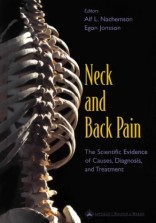|
|
|
| |
 |
|
|

|
 推薦指數:
推薦指數:





|
|
- 內容介紹
|
Neck and Back Pain: The Scientific Evidence of Causes, Diagnosis, and Treatment
by Alf L. Nachemson (Editor), Egon Jonsson (Editor)
Hardcover - 495 pages 1st edition (August 15, 2000)
Lippincott Williams & Wilkins Publishers; ISBN: 078172760X
Editorial Reviews
From The New England Journal of Medicine, January 11, 2001
The primary title of this book, Neck and Back Pain, suggests that it is just another in the large number of books about the neck, back, and spine that have been brought to the market in recent years. The subtitle, however, indicates a different emphasis. Edited by Alf Nachemson, M.D., Ph.D., an orthopedic surgeon and the well-known "conscience" of the spine community, and Egon Jonsson, Ph.D., a professor in health care economics and Principal of the Swedish Council on Technology Assessment in Health Care, this book attempts to consolidate and evaluate critically the scientific information about neck and back pain.
A number of efforts have been made to review and present systematically the scientific evidence on the causes, diagnosis, and treatment of spinal disorders. Having participated in many of these projects, Alf Nachemson is in a unique position to draw from them, and indeed much of this book is based on the work of the Cochrane Collaboration Back Review Group and the Swedish Council on Technology Assessment in Health Care (which is published in Swedish). Reviewing the literature on back pain is not an easy undertaking. Medline searches show that more than 1000 new references appear each year. The authors' selections are based on specified standards of quality, which are appropriately discussed in the introduction to the book.
The book is divided into groups of chapters. Four discuss factors influencing the development of neck and low back pain and the disability caused by the conditions. Although these chapters obviously include epidemiologic issues, a separate chapter on the epidemiology of neck and low back pain reviews some of the previously discussed evidence and adds information about prevalence and incidence. One chapter deals with the assessment of patients, nine with aspects of treatment, and two with cost and cost effectiveness. There is also a chapter on the neurophysiology of back pain that is highly readable but somewhat out of place in the context of this book. Similarly, the review of social-security systems, which is the final chapter, would have been more appropriately integrated into the second chapter, "A Review of Social Influences on Neck and Back Pain and Disability." These, however, are minor flaws that do not detract from the overall value of the book.
The chapters are organized in a consistent format. Initially, there is a description of some of the major studies, and at the end there is a summary and conclusion section. The authors have tried to quantify the strength of the evidence using a four-letter system. This is helpful but obviously involves some degree of subjectivity. Voluminous tables summarize much of the evidence on which these evaluations are based.
The nature of this book makes it somewhat dry, and in many chapters the rationale for the book is repeated. The most important sections of the book are the chapter conclusions. They are succinctly written and well documented by the literature reviews. Although there are no great surprises for those who have followed the literature, it is reassuring to see how well different studies support one another. Unfortunately, for back pain there is limited evidence on a number of topics. There are few randomized, controlled studies comparing surgical with nonsurgical treatment and comparing different surgical techniques. Still, our knowledge has advanced substantially since the review of the Quebec Task Force on Spinal Disorders was published (Spine 1987;12:Suppl:S1-S59).
This book is a valuable source of information for physicians involved in the diagnosis and treatment of patients with neck and back pain and for politicians, insurance systems, providers, and health care planners. All the authors are from Europe -- specifically, Sweden, England, Scotland, and the Netherlands -- which has little influence on the evidence-based chapters but obviously limits the information in the chapter on social-security systems to European countries. Neck and Back Pain is by far the best compilation of information on this subject available to date, and it deserves widespread distribution.
Gunnar B.J. Andersson, M.D., Ph.D.
Copyright © 2001 Massachusetts Medical Society. All rights reserved. The New England Journal of Medicine is a registered trademark of the MMS.
From Book News, Inc.
In addition to orthopedics, contributors come from public health, physical therapy, family medicine, rehabilitation, social work, neurosurgery, and other fields, and almost all from northern Europe. Among the topics are social influences on neck and back pain and disability, work-related influences, epidemiology, assessment, conservative treatment of acute and subacute low back pain, the surgical treatment of lumbar disc prolapse and degenerative lumbar disc disease, the nonsurgical treatment... read more
|
|
|

